Ship commissioning is the act or ceremony of placing a ship in active service and may be regarded as a particular application of the general concepts and practices of project commissioning. The term is most commonly applied to placing a warship in active duty with its country's military forces. The ceremonies involved are often rooted in centuries-old naval tradition.

USS John Paul Jones (DD-932/DDG-32), named for John Paul Jones, was a Forrest Sherman-class destroyer of the United States Navy.
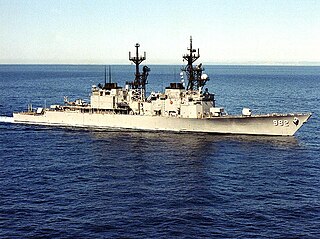
USS Fletcher (DD-992), the thirtieth Spruance-class destroyer, was part of the first major class of United States Navy surface ships to be powered by gas turbines. She was commissioned in July 1980 and was deployed mainly in the western and southern Pacific, but also voyaged to the Indian Ocean and Persian Gulf. She was the second ship in the U.S. Navy to bear this name but the first to be named after Admiral Frank Jack Fletcher. After her decommissioning in 2004, she was sunk in a torpedo test exercise in 2008.

USS Mahan (DDG-72) is an Arleigh Burke-class destroyer currently in service with the United States Navy. This ship is the 22nd destroyer of her class. USS Mahan was the 12th ship of this class to be built at Bath Iron Works in Bath, Maine, and construction began on 17 August 1995. She was launched and christened on 29 June 1996. On 14 February 1998 she was commissioned in Tampa, Florida. Mahan is homeported in Norfolk, Virginia, and as of 2012 was attached to Destroyer Squadron 2. By 2016, the ship was part of Destroyer Squadron 22.
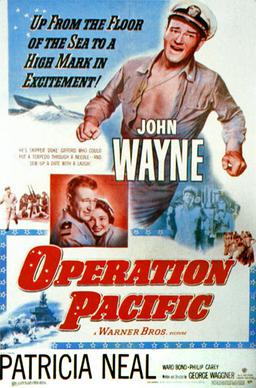
Operation Pacific is a 1951 black-and-white World War II submarine war drama from Warner Bros. Pictures, produced by Louis Edelman, and written as well as directed by George Waggner. John Wayne and Patricia Neal star and Ward Bond and Philip Carey play supporting roles.
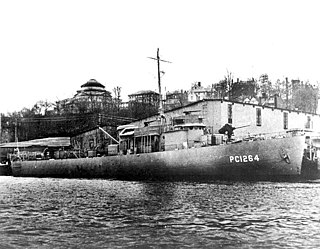
USS PC-1264 was a PC-461-class submarine chaser built for the United States Navy during World War II. She was one of only two U.S. Navy ships to have a predominantly African-American enlisted complement during the war, the other being the Evarts-class destroyer escortUSS Mason.

The First Battle of Fort Fisher was a naval siege in the American Civil War, when the Union tried to capture the fort guarding Wilmington, North Carolina, the South's last major Atlantic port. Led by Major General Benjamin Butler, it lasted from December 24–27, 1864.
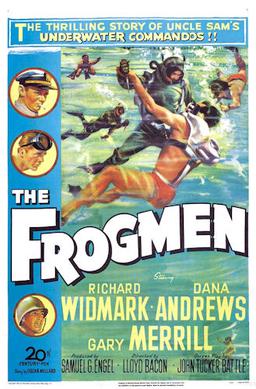
The Frogmen is a 1951 American black-and-white World War II drama film from Twentieth Century Fox, produced by Samuel G. Engel, directed by Lloyd Bacon, that stars Richard Widmark, Dana Andrews, and Gary Merrill. The film's storyline is based on operations by United States Navy Underwater Demolition Teams, popularly known as "frogmen", against the Japanese Army and naval forces. It was the first such film about scuba diving and became a popular cultural hit.
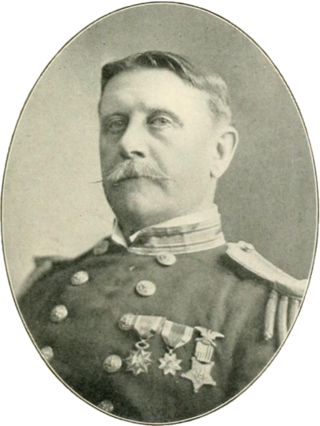
Rear Admiral Oscar Walter Farenholt was an officer in the United States Navy during the American Civil War, the Spanish–American War and is the first enlisted man in the Navy to reach flag rank.

USS Hobson (DD-464/DMS-26), a Gleaves-class destroyer, was the only ship of the United States Navy to be named for Richmond Pearson Hobson, who was awarded the Medal of Honor for actions during the Spanish–American War. He would later in his career attain the rank of rear admiral and go on to serve as a congressman from the state of Alabama.

The Wackiest Ship in the Army is an American comedy drama adventure television series that aired for one season on NBC between September 19, 1965, and April 17, 1966. Produced by Harry Ackerman and Herbert Hirschman, the series was loosely based on the 1960 film starring Jack Lemmon and Ricky Nelson, which itself was a fictionalized account of a real wartime vessel.

USS Echo (IX-95), an unclassified miscellaneous vessel, was the only ship of the United States Navy to be named for the nymph Echo. A sailing scow, she was used as a supply ship in the South Pacific from 1942 to 1944.

Submarine Command is a 1951 American war film directed by John Farrow and starring William Holden, Don Taylor, Nancy Olson, William Bendix, and Darryl Hickman. It is notable for being one of the first films to touch on post traumatic stress disorder. Holden invested $20,000 of his own money into the film. The film received a mixed reception: it was panned by some critics for its brooding melodrama whilst being praised by others.

Don't Give Up the Ship is a 1959 American black-and-white U.S. Navy comedy film from Paramount Pictures, produced by Hal B. Wallis, directed by Norman Taurog, that stars Jerry Lewis and co-stars Dina Merrill, Diana Spencer, Claude Akins, Robert Middleton, Gale Gordon, and Mickey Shaughnessy. The film was shot from October 21, 1958 to January 30, 1959 and was released June 16, 1959. The film was based on the Alcoa Theatre episode Souvenir aired on Dec 2, 1957 starring Jack Lemmon that was written by Ellis Arnold Kadison. Kadison's idea was based on Edward Anhalt then serving with the Army Air Force First Motion Picture Unit in Culver City, California signing for a captured German Messerschmidt that was to be used as a prop in a training film. When the aircraft disappeared, Anhalt was issued with a bill from the US Government for $175,000 until a search revealed that the aircraft was discovered as a mockup on the MGM backlot.

USS Hanson (DD/DDR-832) was a Gearing-class destroyer of the United States Navy named after First Lieutenant Robert M. Hanson of the United States Marine Corps squadron VMF-215.

USS Harry F. Bauer (DD-738/DM-26/MMD-26) was a Robert H. Smith-class destroyer minelayer in the United States Navy. She was named for Lieutenant Commander Harry F. Bauer (1904–1942).

You're in the Navy Now is a 1951 American war-comedy film about the United States Navy in the first months of World War II. The film was directed by Henry Hathaway and stars Gary Cooper as a new officer wanting duty at sea but who is instead assigned to an experimental project without much hope of success. It was released by 20th Century Fox and its initial release was titled U.S.S. Teakettle. When the film failed to gain an audience, it was re-titled to the present title.
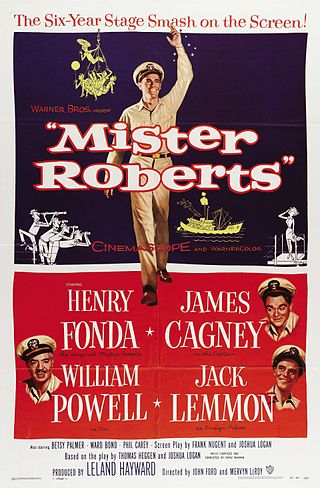
Mister Roberts is a 1955 American comedy-drama film directed by John Ford and Mervyn LeRoy featuring an all-star cast including Henry Fonda as Mister Roberts, James Cagney as Captain Morton, William Powell as Doc, and Jack Lemmon as Ensign Pulver. Based on the 1946 novel and 1948 Broadway play, the film was nominated for three Academy Awards, including Best Picture, Best Sound, and Best Supporting Actor, with Lemmon winning the latter.
USS Nathan James is a fictional guided missile destroyer of the United States Navy, used as the setting for the 1988 post-apocalyptic novel The Last Ship and the television series of the same name

Laurence Allen Abercrombie was a decorated commander during World War II who reached the rank of Rear Admiral in the United States Navy. Admiral Abercrombie was thrice awarded the Navy Cross, the United States military's second-highest decoration awarded for valor in combat.


















